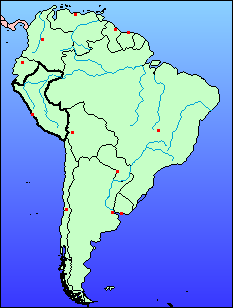 |
Peru is located in the Southern Hemisphere, with 6.940 km of borders (Bolivia, Brazil, Chile, Colombia and Ecuador). Its total area, including its islands on the Pacific Ocean and on the Titicaca Lake is 1.285.216 sq. km. (2.5 times France); with a coast line of 3.079,5 km and a maritime domain of 200 miles along the coast. Its relief is complete and varied but it isn't showed on the coast, on the mountain plains or on the Andean tops, down the valley of the upper forest and on the huge Amazon plain. It has also large contrasts, with a very uneven topographical relief on the Andean slopes; on the high mountain areas that exceed the Altiplano (covered or not with eternal glaciers snow); and on the abrupt geography of the area before the forest. |
The attempts to classify natural regions in Peru are numerous, considering the empty areas, the ecological regions, the altitude, the weather, the waters, the lands, the flora and fauna. However, the most complete way to define these regions is from an altitude and morphological point of view, which indicates the existence of the following regions:
Peru is one of the countries in the world that has very large weather diversity, consequence of several geographical factors, but it is mostly due to the presence of the Andes Mountain Range.
On the coast, there are two different regions:
In the Andean region, the weather varies from temperate-hot to freezing. In the middle levels of the Mountain Range (between 2.500 and 3.500 m), the average annual temperature varies between 11°C and 16°C. In this region are located the main inter-Andean valleys.
In the forest, the largest region of Peru (more than 50% of the national territory), from a climatic point of view, we find three very defined regions: the front-forest, the higher-forest and the lower- forest. The first one has a tropical weather, with an average annual temperature between 22°C and 26°C, which makes it the most rainy region of Peru; the second one has also a tropical weather, with an annual temperature of 31°C and few thermal variations during the year, what makes it the warmest one; and the third has a hot and humid weather, with not more than 3.000 mm. of rain.
In consequence, Peruvian weather could be divided in two seasons, dry and humid, varying according to the geographical region. The Coast and the western side of The Andes are in general dry, with summer rains between December and April; during the rest of the year, the coastal drizzle (garúa) appears and the sun is almost invisible. In The Andes, the dry season is from May to September, while the rest of the year is humid. In the eastern side of The Andes, dry months are the same of the high-plains, but the humid season (January to April) is more marked.
The Andes Mountain Range is located in the occidental side of South America; it goes from Cape Horn, in southern Chile, to the Northern coast of Colombia and Venezuela.
Peruvian Andes are a part of the Andes Range. Geographers have divided it in three large sectors: Southern, Central and Northern. In the White Range is located the Huascarán glacier, which is the higher summit of this Range (6.768 m).
Amazonas, Putumayo, Marañón, Huallaga, Ucayali, Urubamba, Napo, Madre de Dios, Tambo, Tigre, Purús, Pisco, Morona, Camaná, Majes, Colca, Pastaza, Santa, Santiago, Piura, Ocoña, Cañete, Grande, Yurúa, Rímac, Tumbes, Ramis and Coata.
The coast, with desert predominance, includes the main cities of Peru, as well as the biggest road, the Pan-American (Carretera Panamericana).
The Peruvian sea, encounter point of the famous Humboldt Current with the El Niño Current, constitutes an appropriate environment to host a large variety of marine species.
Birds and aquatic life are abundant; with colonies of sea lions, Humboldt penguins, Chilean Flemish, Peruvian pelicans, Inca swallows and brown seagulls that are peculiar to this region. Common birds from the high-plains are the Andean condor, the ibis of the Puna, etc.; we also find there llamas, alpacas, guanacos and vicuñas, while on the eastern side of the Andes, we find jaguars, bears and tapirs. The Peruvian flora has a large number of perennial and unique plants.
The abundance of wild life is protected by several parks and national reserves divided in approximately 30 areas that cover almost 7% of the country.
Peru is constituted by different ethnic groups: Indians (45%), half-caste (37%) (Indian & European ancestors), whites (15%), African, Japanese, Chinese and others (3%).